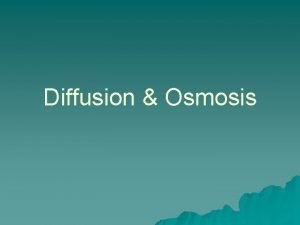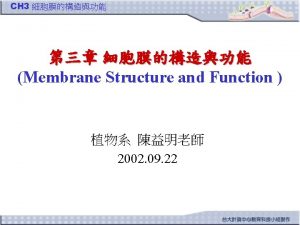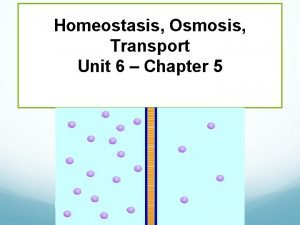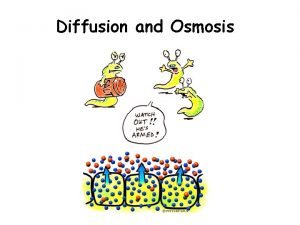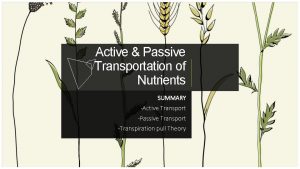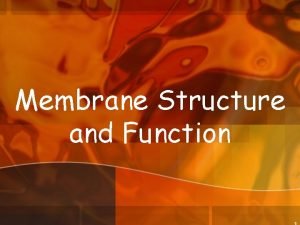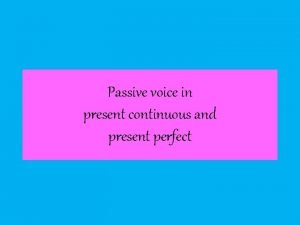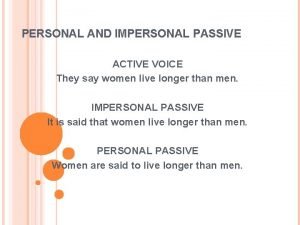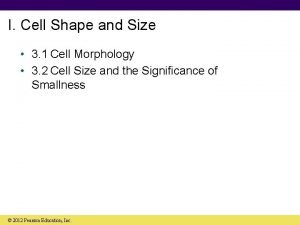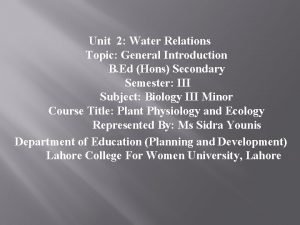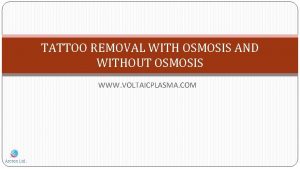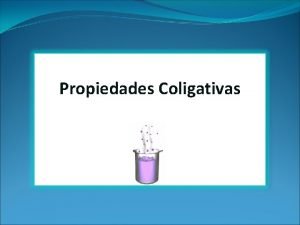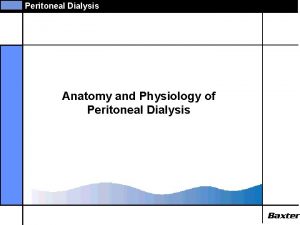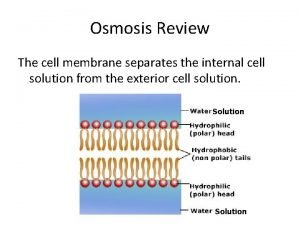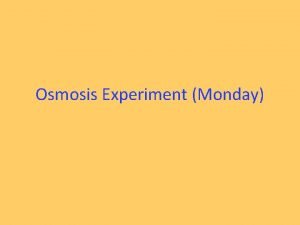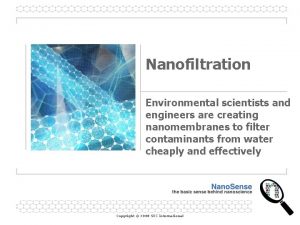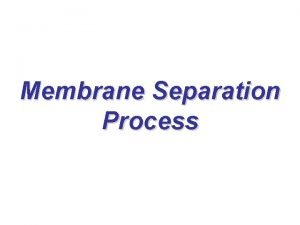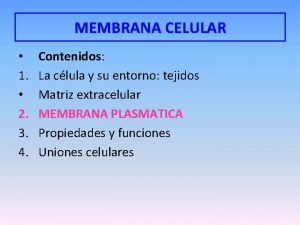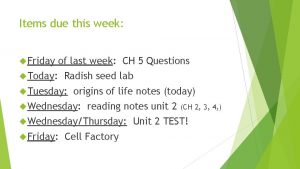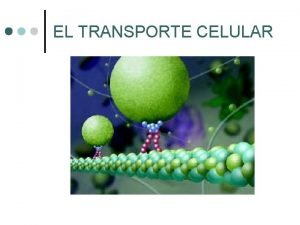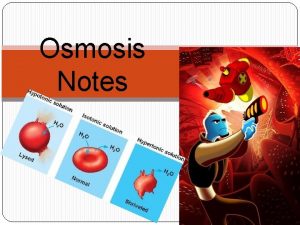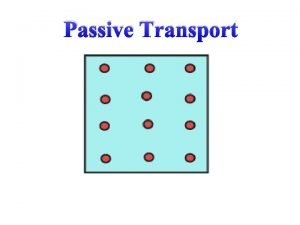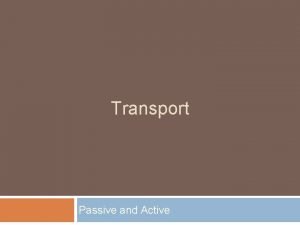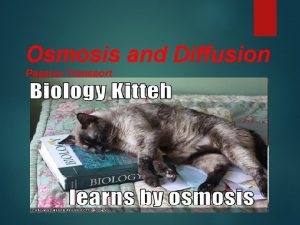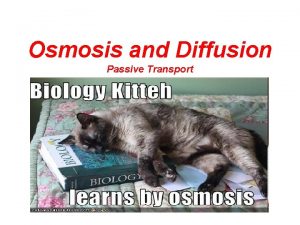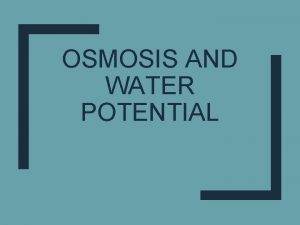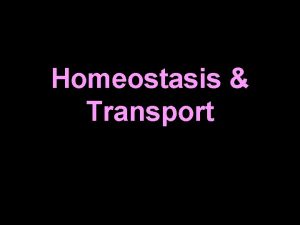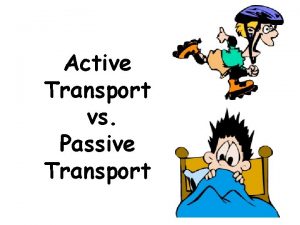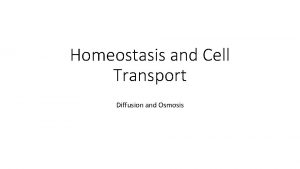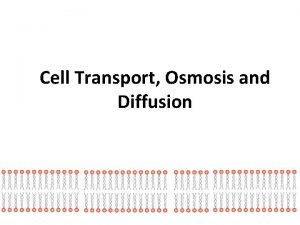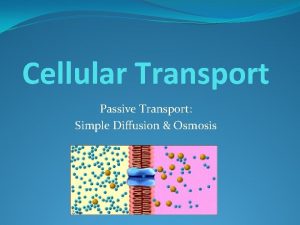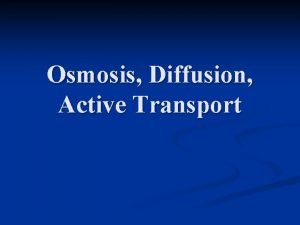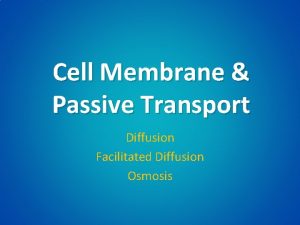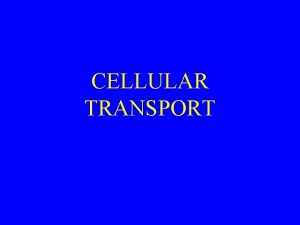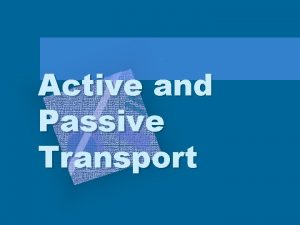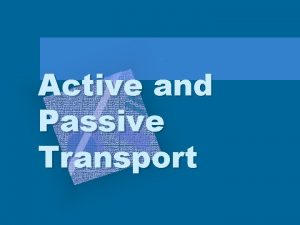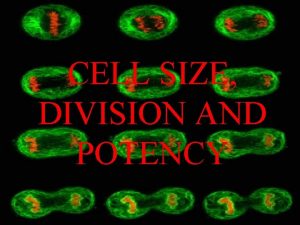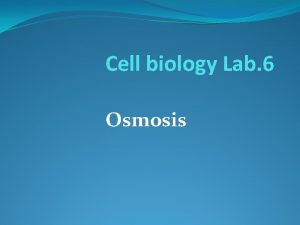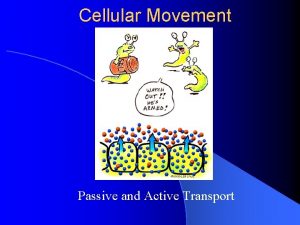Cell Transport Passive Transport and Osmosis Cell Size





























- Slides: 29

Cell Transport Passive Transport and Osmosis

Cell Size Large cells: there are few because the larger the cell the more food and waste produced and there is a smaller areas (1 door) to go through Small Cells: have lots of surface areas (doors) to have food and waste pass through – so its easier to survive Surface to volume ratio. The more surface area a cell has compared to the cell’s volume the easier it is to get nutrients .

Cell Wall Plants & Prokaryotes. (not animals) Structural (plant support) & protective role Cellulose Freely permeable

Cell walls of onion skin…

Cell Membrane/Plasma Membrane Cell membrane In ALL cells 1. Function: ▫ Regulates materials entering and exiting the cell. Water Nutrients Waste products 2. Structure: Two layers of phospholipids, proteins Support/protection

The Cell Membrane • Is composed of a phospholipid bilayer • • A barrier; reg. what passes in/out Supports and protects Selectively permeable – only certain things pass through. About 5 nanometers thick (1 nm = 1 Billionth of a meter)

Cell membrane - Structure • A phospholipid contains▫ one head; negatively charged phosphate group that is hydrophilic (water-loving) ▫ two tails of fatty acid chains that are hydrophobic (water fearing)



Cell membrane features • The fluid mosaic model ▫ ▫ it is fluid in nature allowing cell mobility Scattered in the membrane are various proteins which perform various functions: enzyme activity, cell attachment, communicating with other cells, Transporting substances in and out of cell


Permeability • A material is permeable if it allows molecules to pass through. • The cell membrane (plasma membrane) is semipermeable

Passive Transport • Passive transport require NO ENERGY. Molecules move from high to low concentration through the cell membrane. • There are three types of passive transport ▫ Diffusion & Facilitated Diffusion ▫ Osmosis

Diffusion • Diffusion is the movement of small molecules from high concentration to low concentration. (example: Oxygen, CO 2) ▫ Molecules are not stationary, they are constantly moving ▫ Collisions between moving molecules will spread the molecules apart until the molecules are evenly distributed in the available space

Solution - the mixture formed when a substance dissolves in it Solute - the substance that dissolves Solvent - the liquid in the solution

Osmosis • Osmosis is the diffusion of WATER through a permeable membrane

Osmosis • There are three types of solutions you can have ▫ Hypotonic – lower concentration of solutes outside the cell ▫ Isotonic – equal concentration of solutes inside and outside the cell ▫ Hypertonic – higher concentration of solutes outside the cell

Osmosis in Animal Cells

Equilibrium Plasmolysis Animal Lysis Plant Turgid Flaccid Plasmolysis



Facilitated Diffusion • Some molecules are too large for diffusion so they use facilitated diffusion (example: glucose) ▫ In facilitated diffusion there are proteins the plasma membrane that pass the molecule through �Channel Proteins �Carrier Proteins



Active transport • Active transport - Transportation of molecules against a concentration gradient (from regions of low concentration to regions of high concentration) with the aid of proteins in the cell membrane • and energy from ATP


Other types of active transport Endocytosis – import of materials into cell by infoldings of the cell membrane. A. phagocytosis – “cell eating”; extensions of the cell membrane surround the food and make a vacuole. Lysosomes then secrete enzymes into vacuole to digest food. B. pinocytosis – “cell drinking”; smaller infoldings allowing droplets of liquid to enter cell.

Endocytosis in general

Exocytosis – reverse of endocytosis v. Dumping of excretions or wastes outside by discharging them from waste vacuoles. v. Also can result in secretion of substances (ex: gland cells secreting hormones into the bloodstream)
 Active transport diagram
Active transport diagram Is osmosis active or passive
Is osmosis active or passive Passive osmosis
Passive osmosis Now answer the questions
Now answer the questions Passive transport vs active transport venn diagram
Passive transport vs active transport venn diagram Unlike passive transport, active transport requires *
Unlike passive transport, active transport requires * Osmosis water and salt
Osmosis water and salt Receptor - mediated endocytosis
Receptor - mediated endocytosis Symport
Symport Membrane structures that function in active transport
Membrane structures that function in active transport Active and passive transport
Active and passive transport Difference of active and passive transport
Difference of active and passive transport Const char *s =
Const char *s = Disadvantages of size separation
Disadvantages of size separation Passive present perfect continuous
Passive present perfect continuous Personal and impersonal passive exercises
Personal and impersonal passive exercises Cell shape and size
Cell shape and size Calculating water potential
Calculating water potential Importance of osmosis
Importance of osmosis Transporte celular osmosis
Transporte celular osmosis Osmosis tattoo
Osmosis tattoo Propiedades constitutivas
Propiedades constitutivas Peritoneal equilibration test
Peritoneal equilibration test Hypertonic osmosis gym
Hypertonic osmosis gym Osmosis research questions
Osmosis research questions Nanofiltration vs reverse osmosis
Nanofiltration vs reverse osmosis Osmosis equation
Osmosis equation Que funcion cumple la membrana plasmatica
Que funcion cumple la membrana plasmatica Water potential examples
Water potential examples Moleculas de agua
Moleculas de agua

